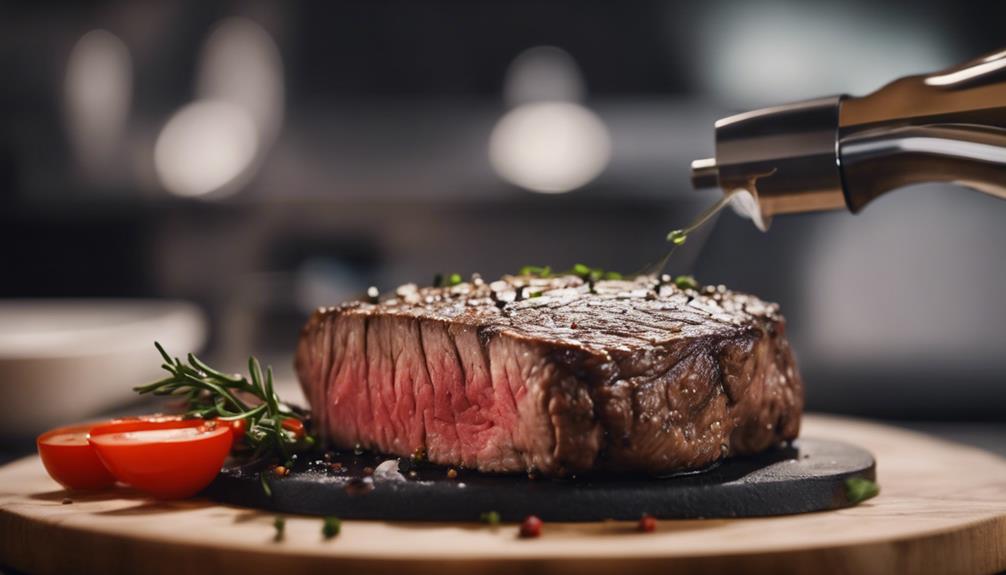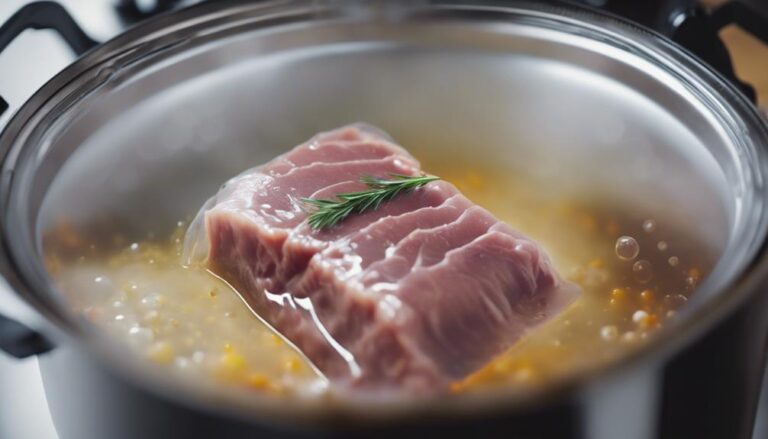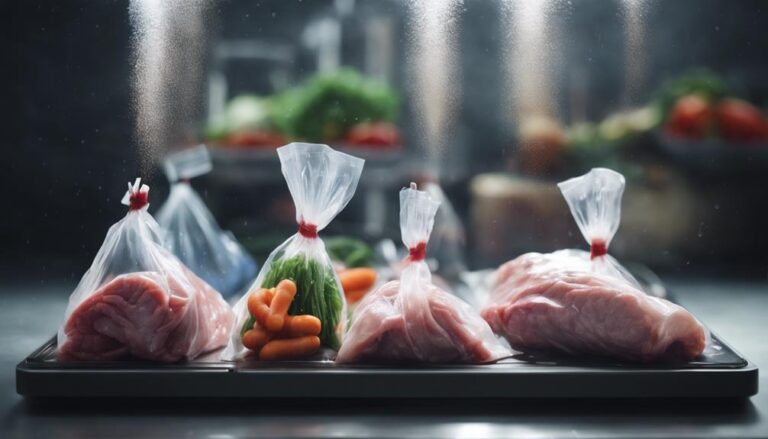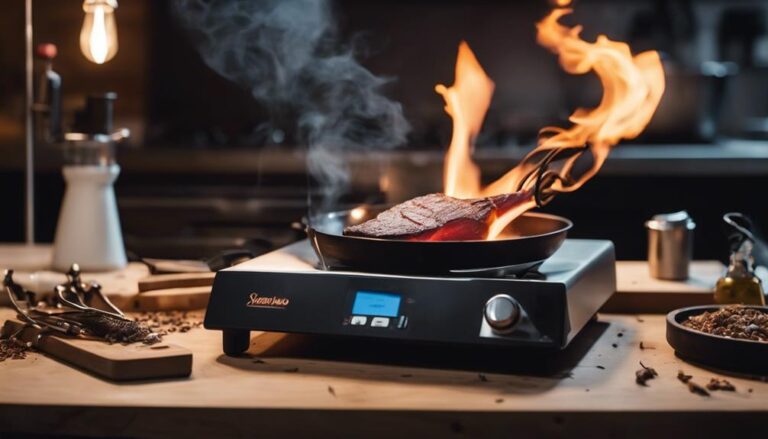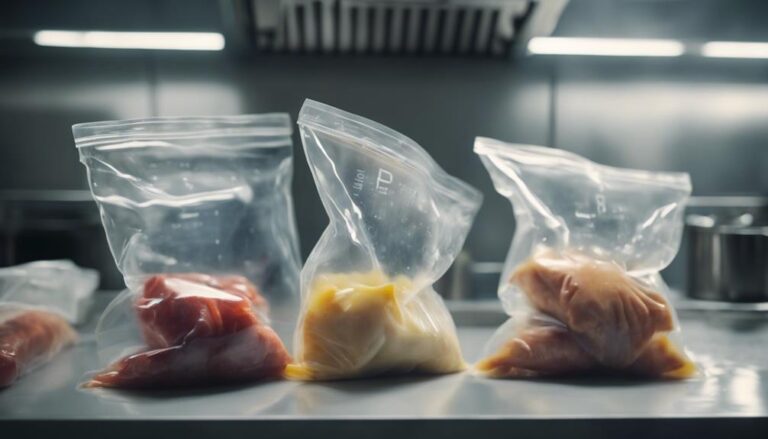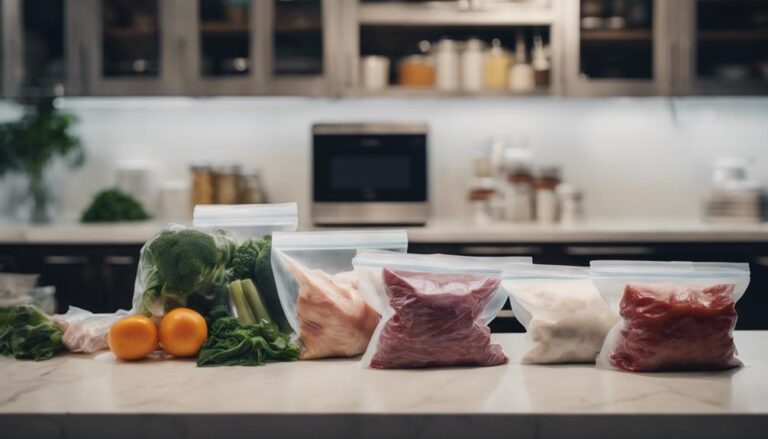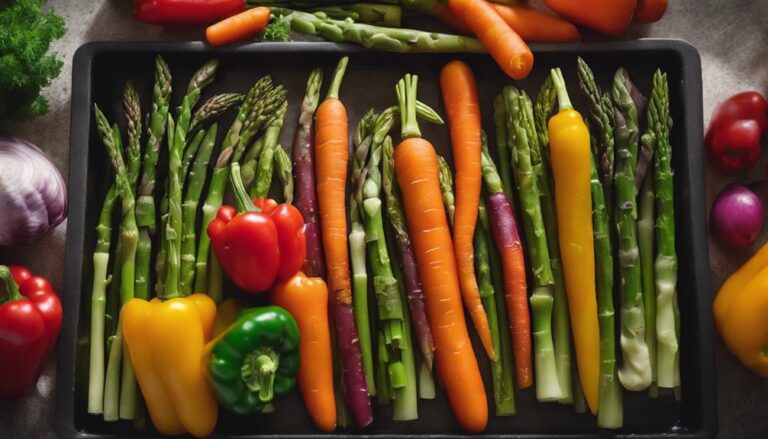Avoiding Overcooked Disasters: the Importance of Sous Vide Temperature Control
Mastering sous vide cooking demands precise temperature mastery. Set temperatures accurately for perfect results. Avoid overcooked, dry dishes by monitoring and adjusting carefully. Follow recommended guidelines for each food type. Common mistakes stem from incorrect settings, impacting texture. Achieve culinary success by understanding temperature's role. Temperature mastery guarantees safety and deliciousness. Make sure to grasp the importance of temperature control in sous vide.
What You Will Learn Here
- Proper calibration prevents temperature inaccuracies.
- Following recommended settings crucial for perfect dishes.
- Adjust temperatures carefully to avoid overcooking.
- Understanding ideal temperature range is essential.
- Monitoring and adjusting temperature ensures precise cooking.
Common Misconceptions About Sous Vide Temperatures
When delving into the world of sous vide cooking, it's important to debunk some common misconceptions surrounding temperature settings. In sous vide cooking, precise temperature control is essential to avoid overcooking disasters. One common misconception is that higher temperatures lead to faster cooking or better results. However, understanding the relationship between time and temperature is critical for successful sous vide dishes. It's essential to follow recommended temperature guidelines in sous vide recipes to minimize the risks of overcooking.
To guarantee accurate temperature settings, proper calibration of sous vide equipment is necessary. This calibration ensures that your sous vide device maintains a precise temperature throughout the cooking process. By dispelling the myth that higher temperatures equate to better outcomes, you can achieve consistent and delicious results in your sous vide dishes. Embrace the recommended temperature guidelines, and remember that precision in temperature control is key to mastering the art of sous vide cooking.
Importance of Precise Temperature Control
Accurate temperature control is a fundamental aspect of sous vide cooking, guaranteeing consistent and precise results. Maintaining the correct temperature is not only essential for food safety and preventing bacterial growth but also impacts the texture and doneness of the final dish. In sous vide cooking, small temperature variations can make a significant difference in the outcome. Sous vide machines provide exact temperature settings, allowing you to have specific control over the cooking process. Understanding the relationship between time and temperature is key to achieving the desired outcomes in sous vide cooking. To highlight the importance of accurate temperature control, let's look at the following table:
| Significance of Accurate Temperature Control | Benefits |
|---|---|
| Consistent Results | Guarantees every dish is cooked to perfection |
| Food Safety | Prevents detrimental bacteria growth |
| Texture | Preserves the desired texture of the food |
| Sous Vide Machines | Offers precise temperature settings |
| Time and Temperature | Understanding the connection for optimal outcomes |
Common Mistakes in Temperature Settings
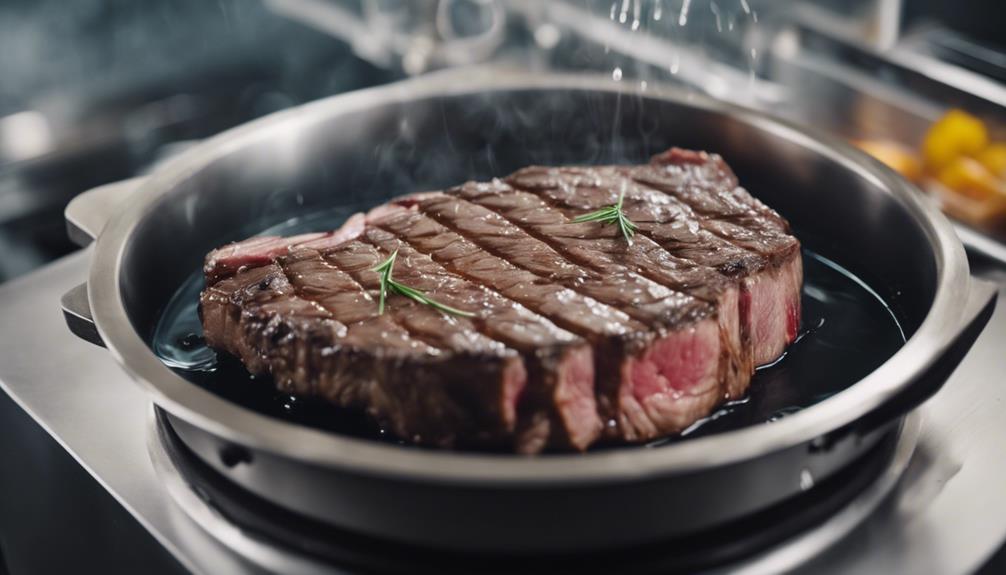
Making mistakes in temperature settings can greatly impact the outcome of your sous vide cooking, leading to undesirable results. In sous vide cooking, temperature control is key to achieving the perfect dish. Setting the wrong temperature can result in overcooked, dry, or tough food, diminishing the quality, flavor, and juiciness of your ingredients.
Precision in temperature control is essential for ensuring that your food reaches the ideal temperature for best texture and doneness. Failure to follow recommended settings can lead to inconsistent or disappointing outcomes in your sous vide dishes. It's important to understand the ideal temperature range for different foods to achieve the best results.
Avoiding Overcooking With Temperature Adjustments
To prevent overcooking in sous vide cooking, adjust temperatures carefully to make sure your food reaches the desired level of doneness without becoming mushy or tough. Temperature adjustments play an important role in sous vide cooking, allowing you to have precise control over the texture and doneness of your dishes. By monitoring and adjusting the temperature throughout the cooking process, you can guarantee that your food turns out just the way you like it – perfectly cooked and full of flavor.
Understanding the impact of temperature on different types of food is essential for achieving successful results in sous vide cooking. Whether you're cooking a delicate piece of fish or a hearty cut of meat, accurate temperature control is key to maintaining the integrity of your ingredients. By being mindful of temperature settings and making adjustments as needed, you can avoid the disappointment of overcooked meals and instead serve up dishes that are consistently delicious and perfectly cooked.
Temperature Guidelines for Sous Vide Success
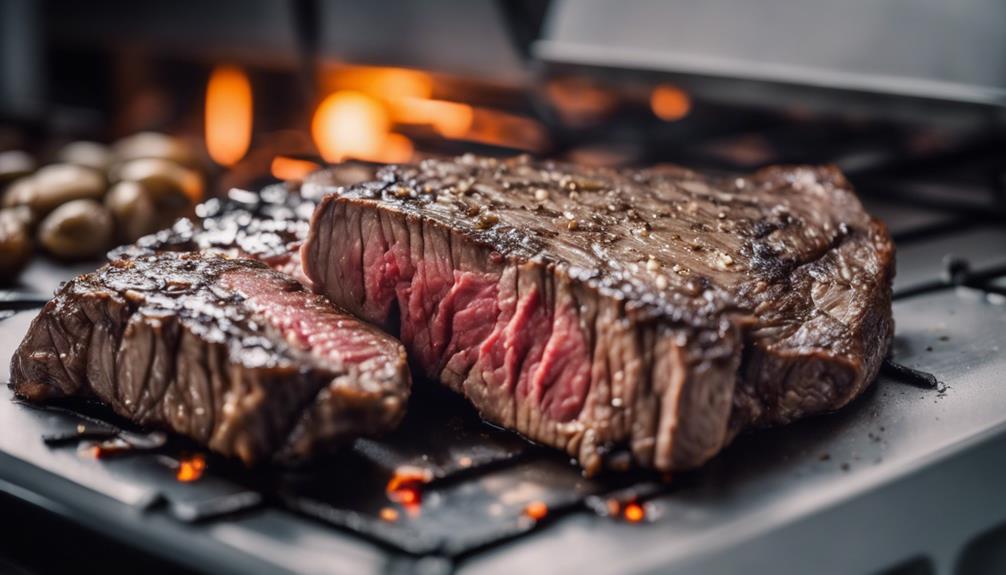
For successful sous vide cooking, it's essential to adhere to specific temperature guidelines tailored to the type of food you're preparing. Sous vide cooking relies on precise temperature control to guarantee the desired results. Each food item has an ideal temperature range that assures both food safety and perfect texture. Common mistakes in sous vide cooking often stem from incorrect temperature settings, leading to overcooking or undercooking.
To prevent overcooking, it's vital to set the sous vide machine to the recommended temperature for the specific food you're cooking. Overcooking can result in a loss of flavor, moisture, and tenderness. Understanding the ideal temperature range for different foods is crucial to avoid such mishaps. By following the temperature guidelines closely, you can ensure that your sous vide dishes turn out perfectly cooked and delicious, ready to be served to your guests. Remember, precise temperature control is the key to sous vide success.
Troubleshooting Temperature Issues in Sous Vide
When troubleshooting temperature issues in sous vide, focus on calibration for precision and ensuring your monitoring device accuracy. These steps are paramount in maintaining the desired temperature levels throughout the cooking process.
Calibration for Precision
Achieving precise cooking in sous vide requires meticulous calibration of your machine's temperature settings. Calibration is essential for maintaining accuracy in temperature control, ultimately impacting your cooking outcomes.
Use a reliable thermometer to verify the precision of your sous vide machine's readings. Regular calibration not only guarantees accuracy but also consistency in achieving the desired results for your dishes.
Throughout the cooking process, monitor and adjust the temperature settings as needed to uphold precision in your sous vide cooking. By paying attention to calibration and making necessary adjustments, you can elevate the quality of your sous vide dishes and serve delectable meals with confidence.
Monitoring Device Accuracy
To guarantee precise sous vide cooking, monitoring the accuracy of your device is essential for troubleshooting temperature issues effectively. Sous vide temperature accuracy impacts the outcome greatly, with even small variations affecting your results.
Regularly calibrating your sous vide devices is vital to confirm accurate temperature readings and consistent cooking. Use a reliable thermometer to verify the water bath temperature, preventing undercooked or overcooked food.
Pay attention to the placement of your sous vide machine, as it can influence temperature readings; make adjustments for best performance. Understanding temperature gradients within the water bath is key to maintaining uniform heat distribution, ensuring your food cooks evenly.
Achieving Perfection Through Temperature Mastery
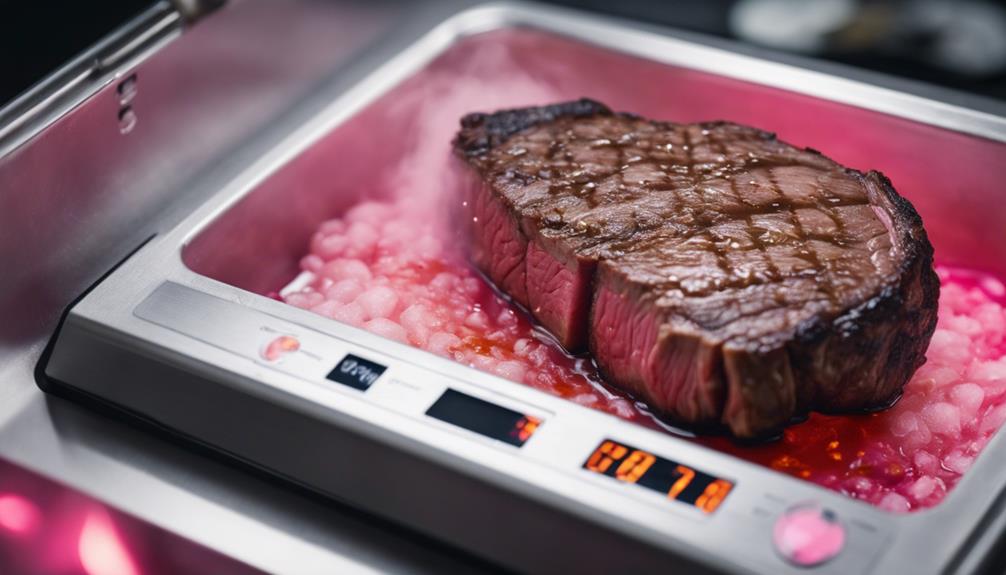
With precise temperature mastery in sous vide cooking, you can elevate your dishes to perfection. When preparing sous vide recipes, temperature control is your key to success. Not only does it enhance the flavors and textures of your dishes, but it also guarantees food safety by effectively pasteurizing ingredients.
By making precise adjustments to the temperature settings, you minimize overcooking risks that can lead to undesirable outcomes. Customization is essential as different types of food require specific temperature settings for best cooking results. Sous vide technology empowers you to have control over the cooking process, allowing you to achieve perfect outcomes consistently.
Avoid common mistakes by paying close attention to temperature management, as it's the foundation of sous vide cooking excellence. Embrace temperature mastery, and watch as your culinary creations reach new heights of deliciousness.
Frequently Asked Questions
What Are the Guidelines for Sous Vide Food Safety?
For sous vide food safety, handle properly, follow time limits, cool swiftly, prevent bacterial growth, vacuum seal securely, use pasteurization techniques, be cautious of temperature danger, avoid cross-contamination, and monitor shelf life for safe consumption.
Can You Overcook in a Sous Vide?
Yes, you can overcook in a sous vide. It's important to follow recommended cooking times and maintain precise temperature control to avoid texture changes, flavor loss, and protein breakdown. Quick chilling and proper searing help prevent overcooking.
Why Is Sous Vide Bad for You?
Sous vide is safe when you follow proper guidelines. Health risks in sous vide come from improper temperature control, leading to foodborne illnesses. Avoid potential toxins by handling food safely, maintaining precise cooking temperatures, and preventing undercooked meals.
What Is the Warning About Sous Vide?
Proper temperature control is essential in sous vide cooking. It guarantees precise cooking, maintains food texture and flavor, and prevents disasters. Pay attention to equipment, water circulation, and recipes for successful sous vide techniques and delicious results.
Conclusion
So remember, when it comes to sous vide cooking, precise temperature control is key to avoiding overcooked disasters.
By understanding the common mistakes in temperature settings and following temperature guidelines, you can achieve perfection in your dishes.
Don't let temperature issues ruin your sous vide experience – with a little practice and attention to detail, you can master the art of temperature control and create delicious, perfectly cooked meals every time.
Happy cooking!
